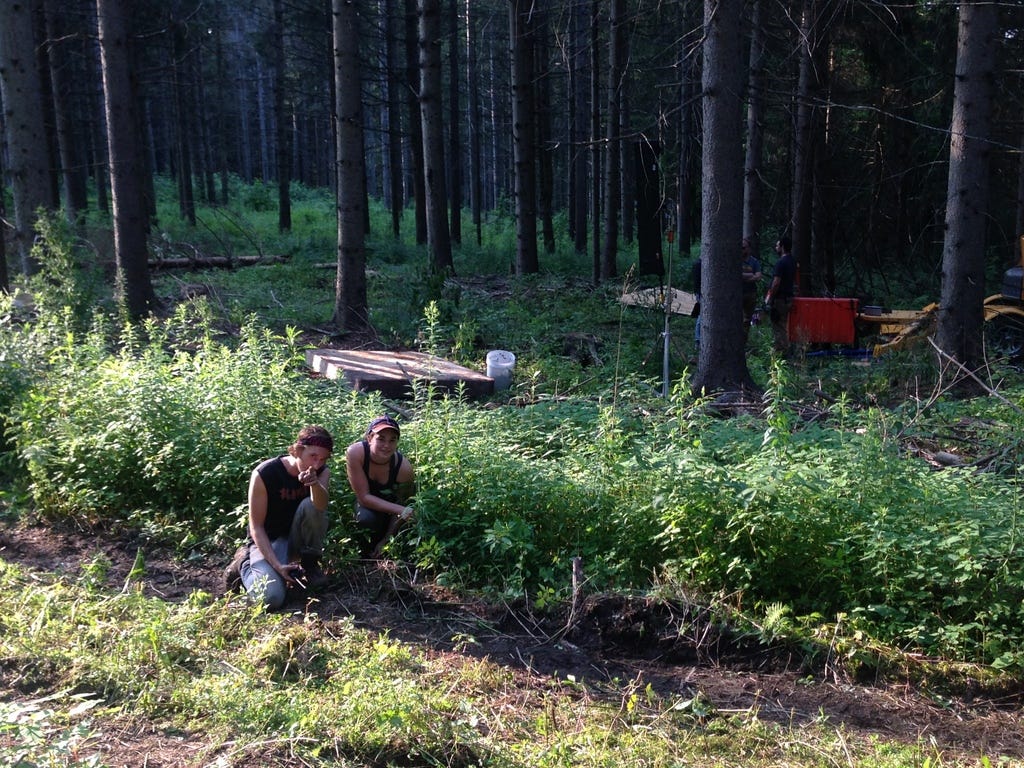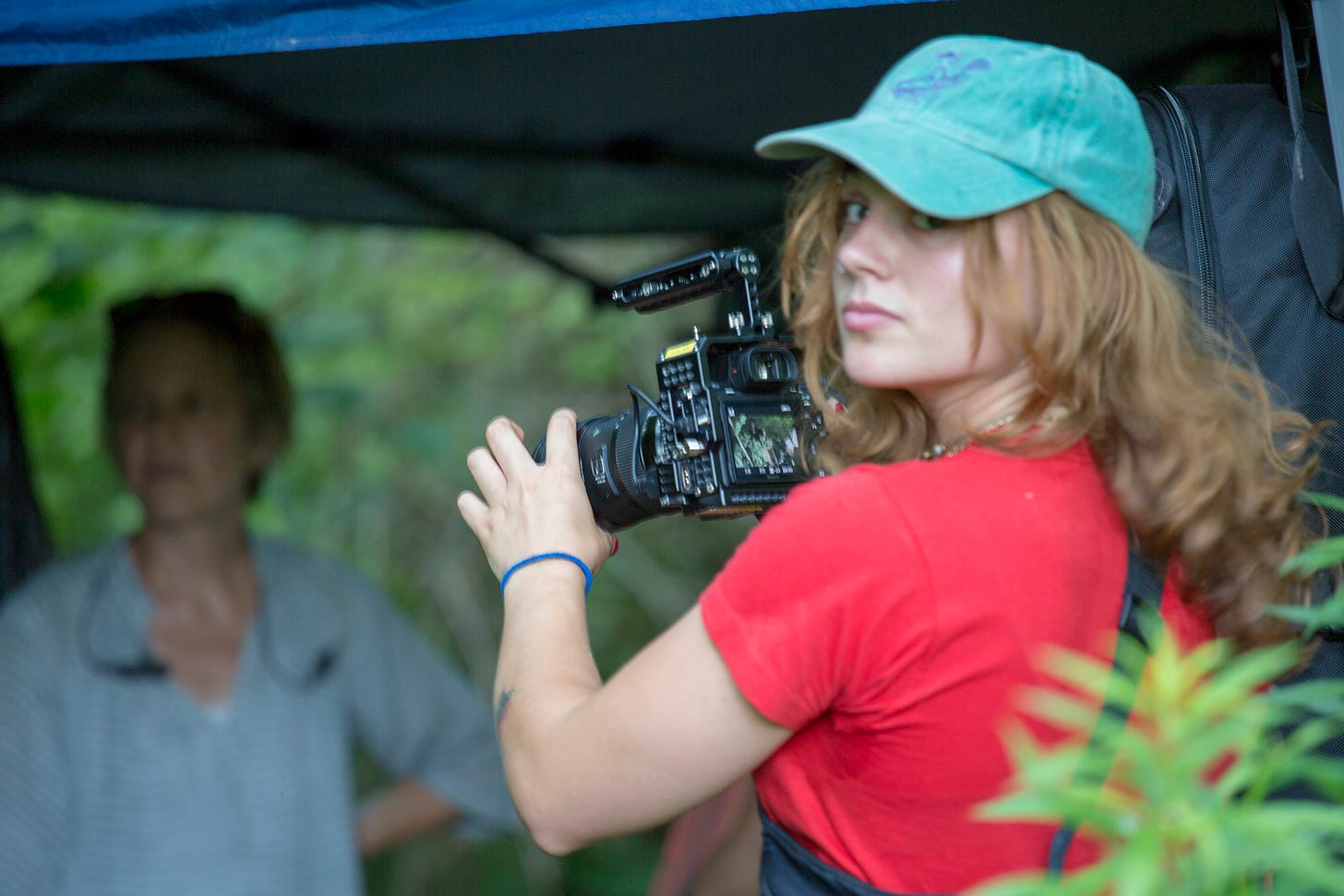The following was written by Harper Glantz, the filmmaker of Making Eveningside:
My first job on Gregory’s set was working as a grip production assistant on the summer 2014 production of Cathedral of the Pines when I was 15. Brandon Taylor (key grip), Justin Hullinger, (grip) and Nicola Guarneri (gaffer) walked me through every piece of equipment on the grip truck, and I remember crouching just out of frame in the ferns of the Becket woods with Brandon during golden hour on the set of The Mattress as he took the time to point around and show me what each light was doing in the shot. It was miraculous to realize that all we see is light, and figure out how to manipulate that. I also quickly became aware that Rick Sands, the Director of Photography and master of all light on Gregory's productions, was exponentially to them what they were to me, a giant amongst men, a savant and prophet of light and shadow. The physical demands and mechanics of rigging and positioning the lights and the creative mathematics of ensuring their proper effect was enchanting to me. So were the personalities of G&E [the grip and electrics] to which I felt a strong kinship. I also became friends with Paige Carter as well, who is and has been primarily responsible for Gregory's props, set dec. and wardrobe since the beginning [Paige joined the team on Twilight 1998-2002 and has worked on every series since.] The extent and quality of all the departments' efforts, as well as their attitudes, shined a unique light on the entire world for me during that period. I didn’t know then that I had begun my study of them.
I continued to work with many of them over the following years. It became a clearly treasured and special time when we gather to work on Gregory’s productions. Furthermore, these events take place in my home town of Pittsfield, MA where I was raised and currently live. My mother Juliane Hiam, Gregory's partner, manager of Crewdson Studio and Gregory's creative partner, was also born in Pittsfield and raised mostly in Becket, MA. This area feels a bit private to me. When I'm home, I feel like the rest of the world is on another floor of the apartment. This has added a surreal quality to the productions, to work with giants in such a space as this.
Another thread in this story is that I've appeared in several pictures over the past ten years in addition to working grip side on production. Oftentimes I have stood for pictures dressed in my real clothes in these familiar settings. The first picture we shot on the Eveningside production was 8-10 Cleaning Services, which I was also in. I filmed BTS material up until I sat on the ledge in the uniform. Similarly, on previous productions, I helped to set lights for a picture and then, moments later, was positioned in it. It is a distinct blur of organic and constructed reality.
I thought the idea was cool of aiming a camera in the direction of the crew while they work hard to create a world that exists on the plane opposite to them, 180 degrees away; the world that appears on monitor, while I, with yet another degree of separation, look at them on my monitor. This arrangement on set is usually a one way mirror. In choosing to edit for two simultaneous videos playing as one, I hoped to subtly reflect this idea.
Windows and mirrors have some things in common, and to me, are also interesting symbols for inner cerebral experiences. Windows separate one plane into two completely unique planes. A window also forces a distinction between outside and inside. Whichever side you can see through the window feels removed because of the glass; less real. A window can also function as a mirror when the glare bounces your own reflection back to you on top of the view through the glass, so you can witness both scenes at once. A mirror bounces one image back, a nearly identical image, except it is reversed. A look into a mirror can also make the reflection of the world feel removed; even though it is an exact duplication, it is still something contained that you can watch. We can even watch ourselves watching.
Windows and reflections appear as a theme in the Eveningside pictures, which inspired me to stylistically incorporate this into the edit of the BTS footage.
A couple months after production had concluded on Eveningside, Stuart Bogie and James Murphy offered two 20 minute long pieces of music which will appear in the form of a record, one side titled "Morningside" and the other "Eveningside." Gregory wanted this music to be the only sound in the piece, which distilled the material into a more essential form. I love and admire dance and physical movement as a means to communicate, so I saw this as an opportunity to be guided by these aspects of the movement within the frame, the camera movement, and the music, to choreograph the edit. I'm also fond of the 20-minute timeframe because it is the same amount of time as a Transcendental Meditation session, a practice which I learned a couple years ago when I spent a semester at Maharishi University in Fairfield, IA. and have sometimes (on a good day) incorporated into my day. The similarity to TM occurred to me when I listened to the pieces because of their meditative quality, which I believe played a role for Stuart Bogie in his creation of it, too.
Dealing with two separate timelines at once was natural for me and felt correct for the project. I really like the Morningside and Eveningside neighborhoods in Pittsfield as a sustaining theme throughout the Eveningside Universe. Considering two timelines felt authentic to me, as my experience, in a broader way, as is probably human nature, also involves considering at least two timelines. For example, the notion of past, present and future. I have major depressive disorder and very frequently fall into depressive episodes. I'm aware of both the timeline I'm experiencing privately and other timelines progressing in the outside world. Editing and presenting two images at once was reminiscent of familiar thought processes.
Gregory wanted this piece to be atmospheric and transporting, to not diverge from the tone of the pictures, and to not explain things about the process, but instead to offer some moments to experience in each's own way and with space enough for mystery. I hope the piece welcomes some moments not only of stimulation, but of inner reflection. I thank Gregory and my mom Juliane Hiam for trusting me to present this piece in support of Eveningside. Thanks especially to my mom. Thanks to Christian Badach for supporting me in the studio over the past year. Thank you to the crew of Eveningside for allowing me to film you.
Thank you to James Murphy and Stuart Bogie for sharing the beautiful and interesting pieces of music. Thank you to Michele Coppola and Gallerie d’Italia, Antonio Carloni, Maura Dettoni, Michela Garosi, and the technical team for facilitating the video installation in your state of the art Immerssive Hall, a piece of art in itself.





